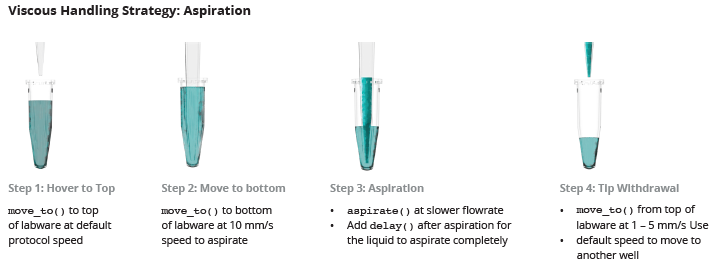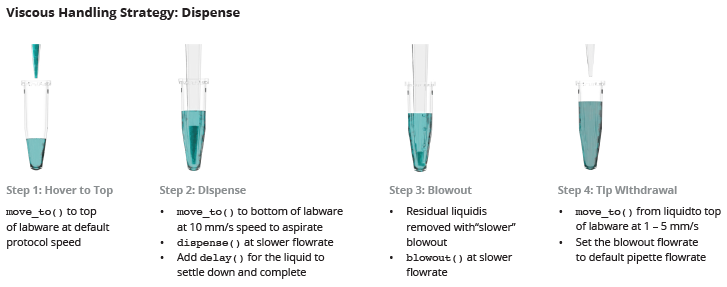Sponsored Content by OpentronsReviewed by Louis CastelMar 29 2024
Molecular assays necessitate accurate pipetting reagents and samples with a diverse set of properties — including viscous samples that can clog tips, distribute unevenly, and complicate reproducibility. The Opentrons OT-2 is an automated liquid-handling robot that is capable of pipetting these difficult liquids. The default parameters in the Opentrons Protocol Python API are optimized for the accurate and efficient handling of aqueous reagents.
Commonly used reagents exhibit differences in viscosity, evaporation rate, and surface tension, among other properties. These inherent characteristics of liquids necessitate adjustments to default protocol parameters to ensure optimal handling within specific workflows.
This article will delve into some of the best practices to automate the handling of viscous liquids using the Opentrons OT-2 based on testing performed using computer vision-based methods and gravimetric methods.
Methods
Using the OT-2, Opentrons optimized the process for handling viscous liquids as it took into account the rheological characteristics of the liquids, pipette specifications, and labware profile.
The Opentrons GEN2 Single-Channel pipettes’ viscous liquid handling capabilities were the only subject of this investigation.
The liquid handling functions that were used were aspiration and dispense; the parameters, however, may not work when complex liquids are mixed or formed. Different workflows may require different parameters.
Materials
Glycerol 99% (Sigma-Aldrich, G5516) was diluted with the appropriate amounts of molecular grade water (Invitrogen, cat. no. 10977023) to create various dilutions. Glycerol is a viscous liquid with a variable viscosity that varies with dilution, ranging from 1 mPa.s to 1400 mPa.s.
Glycerol is, therefore, considered to be a representative liquid of viscous class, enabling a qualitative understanding of viscosity and comparing it with liquids of similar viscosity.
Glycerol 10 %, 90 %, and 99 % were selected for parameter development due to the exponential increase in viscosity of the substance. Ten milliliters of a total mixture of glycerol and water in two proportions—90 % glycerol and 10 % glycerol—were used to make each concentration in a 15-ml Falcon tube.
Opentrons 15 tube rack adapter was placed on rack 7. The testing was performed using Opentrons GEN2 Single-Channel V2.2 pipettes: P20, P300, and P1000. Opentrons P20 Tips and Opentrons P300 Filter Tips and Opentrons P1000 Filter Tips were also used. Temperature and humidity were monitored using an integrated thermometer and hygrometer.
Gravimetric testing methodology
Gravimetric testing was carried out using an OT-2 coupled to a specially constructed rig with a weighing scale. To isolate the vibrations caused by OT-2, the scale was set up on a different bench. Using molecular grade water, glycerol concentrations of 10%, 90%, and 99% were evaluated using gravimetric testing equipment. With four repeats per volume, three volumes of 1 uL, 10 µL, and 20 µL were evaluated using the Opentrons P20 GEN2 pipette.
Pipettes of 20 µL, 150 µL, and 300 µL were evaluated with 10 repetitions per volume using the Opentrons P300 GEN2 pipette. Pipettes of 100 µL, 500 µL, and 1000 µL were also evaluated with 10 repetitions per volume using the Opentrons P1000 GEN2 pipette. The testing was conducted in a room with an ambient temperature between 23 °C to 32 °C and a relative humidity between 35 and 45 %.
Appendix Tables A1, A2, and A3 set parameters were used in Opentrons Python Protocol API 2.9 to program the OT-2 to execute aspiration, dispense, and blow out at specified flow rates. Water was tested using the aspiration, dispense, and blowout default values.
Table A1: Opentrons GEN2 P20 Single-Channel Pipette Optimized Parameters by Liquid. Source: Opentrons
| Pipette |
Liquid |
Aspiration Rate (μL/s) |
Aspiration Delay (s) |
Aspiration Withdrawal Rate (mm/s) |
Dispense Rate (μL/s) |
Dispense Delay (s) |
Blowout Rate (μL/s) |
Touch tip |
| P20 |
Glycerol 10% |
6.804 |
2 |
5 |
6.804 |
2 |
0.5 |
No |
| Glycerol 90% |
5.292 |
7 |
2 |
5.292 |
7 |
0.5 |
No |
| Glycerol 99% |
3.78 |
10 |
2 |
3.78 |
10 |
0.5 |
No |
| PEG 8000 50% w/v |
6.048 |
7 |
5 |
6.048 |
7 |
0.5 |
No |
| Sanitizer 62% Alcohol |
1 |
2 |
20 |
3.78 |
2 |
0.5 |
Yes |
| Tween 20 |
5.292 |
7 |
2 |
3.024 |
7 |
0.5 |
Yes |
| Engine oil |
6.048 |
7 |
1 |
6.048 |
7 |
0.5 |
Yes |
Table A2: Opentrons GEN2 P300 Single-Channel Pipette Optimized Parameters by Liquid. Source: Opentrons
| Pipette |
Liquid |
Aspiration Rate (μL/s) |
Aspiration Delay (s) |
Aspiration Withdrawal Rate (mm/s) |
Dispense Rate (μL/s) |
Dispense Delay (s) |
Blowout Rate (μL/s) |
Touch tip |
| P300 |
Glycerol 10% |
83.25 |
2 |
5 |
83.25 |
2 |
10 |
No |
| Glycerol 90% |
64.75 |
8 |
1 |
64.75 |
8 |
4 |
No |
| Glycerol 99% |
55.5 |
10 |
1 |
55.5 |
10 |
4 |
No |
| PEG 8000 50% w/v |
74 |
6 |
1 |
74 |
74 |
4 |
No |
| Sanitizer 62% Alcohol |
92.5 |
2 |
20 |
92.5 |
2 |
4 |
Yes |
| Tween 20 |
13.9 |
10 |
1 |
13.9 |
11 |
7 |
Yes |
| Engine oil |
74 |
3 |
2 |
46.25 |
7 |
10 |
Yes |
Table A3: Opentrons GEN2 P1000 Single-Channel Pipette Optimized Parameters by Liquid. Source: Opentrons
| Pipette |
Liquid |
Aspiration Rate (μL/s) |
Aspiration Delay (s) |
Aspiration Withdrawal Rate (mm/s) |
Dispense Rate (μL/s) |
Dispense Delay (s) |
Blowout Rate (μL/s) |
Touch tip |
| P20 |
Glycerol 10% |
247.05 |
2 |
30 |
247.05 |
2 |
75 |
No |
| Glycerol 50% |
247.05 |
3 |
30 |
247.05 |
3 |
75 |
No |
| Glycerol 90% |
164.7 |
10 |
3 |
109.8 |
10 |
15 |
No |
| Glycerol 99% |
41.175 |
20 |
1 |
19.215 |
20 |
5 |
No |
Conclusion
The OT-2 with Opentrons GEN2 Single-Channel Pipettes can handle liquids of varying viscosity with accuracy equivalent to the OT-2’s high precision water handling capabilities, according to the findings of viscous testing. The optimized recommended settings and guidance serve to improve the liquid handling performance of OT-2 and help ensure a successful protocol run.
Figures 2 and 3 provide an overview of the viscous liquid class's implementation. The lower flow rates coupled with critical settling times enable viscous liquids to settle; thus, the steps that follow, such as slower blowout, help to reduce the loss of viscous liquid, allowing efficient usage of reagents and improved accuracy in results.

Figure 2. Strategizing an aspiration cycle with Opentrons Python Protocol API. Image Credit: Opentrons

Figure 3. Strategizing a dispense cycle with Opentrons Python Protocol API. Image Credit: Opentrons
If the blowout volume is either too low or too high for dispensing liquid, one approach is to introduce an air gap before aspirating viscous liquids. This can be achieved by using a slower dispense rate instead of adjusting the blowout rate, allowing the air volume to push the viscous liquid out of the pipette tip.
However, this trade-off means that less liquid can be aspirated compared to the pipette's maximum capacity, which may not be ideal for the Opentrons GEN2 P20 Single-Channel pipette. Additionally, it is recommended to use slower withdrawal speeds after aspirating and dispensing to minimize the risk of droplets adhering to the tip and reagents spilling within the labware.
To sum up, the Opentrons OT-2, GEN2 Single-Channel pipettes, Opentrons Tips, and Opentrons Filter Tips are ideal for managing viscous liquids and improving the precision of protocols.